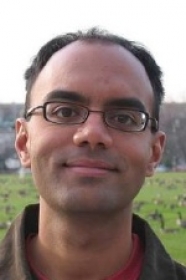
1:00 pm to 12:00 am
Event Location: Newell Simon Hall 1305
Abstract: Recent display applications for entertainment and business have made available new types of illumination using LEDs, DMDs and LCDs, which are bright, energy efficient and cheap. Some of these devices are programmable and allow spatio-temporal control of the emitted light rays. With the advent of such digital light-sources, illumination is becoming a flexible, configurable medium. This has impacted computer vision and spurred techniques that control illumination for analysis of indoor areas, industrial environments, stage/studio sets, underwater scenes, underground locations and outdoor scenes at night. In such methods, the light-source’s programmability is often exploited to create easily detectable features, such as bright stripes or binary patterns.
In this thesis, we extract illumination-based features for three new scenarios by exploiting the motion, occlusion and strobing of light-sources. First, we move a light-source in a smooth and random path. For a static scene, this creates a continuous set of intensities at each pixel. We exploit this continuity to detect brightness maxima and minima at scene points and show how these extrema features relate to geometric cues, such as surface normals and depths. For our second approach, we occlude a light-source using moving opaque masks. Each pixel’s brightness minima, due to the mask shadow, corresponds to a set of blocked incident light rays. These shadow features can be used to render the scene from the light-source’s point-of-view. The third technique exploits the flickering emitted by a strobing source as a temporal feature that is easily detected, even for scenes with fast moving objects. This enables active vision for dynamic scenes, which we demonstrate using DLP illumination.
Our methods work with a variety of indoor and outdoor materials, real-world textures and glossy/metallic objects. We are not restricted to distant point sources and show results with outdoor illumination, sources with intensity fall-off and area/line sources such as indoor fixtures. None of our approaches require a complex or calibrated setup. Some even allow the light-source to be hand-waved in an unstructured manner. In addition, all of our techniques are easy to implement, requiring only a few lines of code. The work in this thesis demonstrates, for the first time, results such as iso-normal clustering of indoor and outdoor scenes, reciprocal views from general, non-programmable sources and very high-speed marker-less motion-capture and photography. Finally, almost all natural and artificial light-sources in our world either undergo motion (or are mobile), get occluded or exhibit strobing (at some frequency). Therefore our algorithms have relevance for real-world illumination and any applications or extensions of these will have significant impact.
Committee:Srinivasa Narasimhan, Chair
Martial Hebert
Alexei Efros
Steven Seitz, University of Washington
